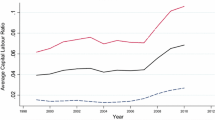Abstract
The post-reform ‘Free market enterprise’ systems and forms of governance adopted in Indian manufacturing have been widely debated and argued to be associated with a jobless manufacturing growth. The study uses market concentration and monopoly power indices, post-reforms, to determine the level of competition and labour exploitation. A panel data regression with employment as the dependent variable has found: Free market enterprise has a semi-definitive impact on the employment of labour. The variables: (1) market concentration leads to an increase in the level of employment and wages. However, (2) monopoly power leads to a decline in the level of employment and an indefinite effect on wage growth. This study is significant in understanding jobless growth and the idea of capital reorganization and labour substitution. The study could relate to formulation of the antitrust policies and restrictive trade practices of monopolies in coherence with labour welfare.
Similar content being viewed by others
Notes
Concentration indices used are Hirschman–
Herfindahl index (HHI) and Concentration Ratio 4 (CR4)
HHI is defined as the sum of square of market shares, implying an industry with one firm has HHI equal to 1, whereas a Herfindahl close to zero implying a large number of firms in the industry with all firms having an equitable market share. The index is worked out using the micro-data of firm’s sales value. HHI = ∑ i = 1,2,3,….,N (100 − S i )2 or HHI = ∑i − 1,2,3,…,N (Market Share i )2.
CR4 = ∑ i − 1,2,3,4. S i /S t . Here S t is the sales of the industry in total for a financial year or a period.
The empirical evidence is through a panel data analysis of market concentration using firm level CMIE data, 1999–2013. Market concentration is calculated using Hirschman–Herfindahl index (HHI) and Concentration Ratio 4 index (CR4) discussed below.
\({\text{Gini}} = \frac{n + 1}{n} - \frac{{2\sum {(n + 1 - i)} }}{n\sum x }\).
\({\text{Mark - up}} = Y_{it} - ({\text{RM}}_{it} - {\text{PF}}_{it} - {\text{SW}}_{it} ) \div Y_{it}\) (Y: Output, RM: Raw Materials Costs, PF: power and Fuel expenditure, SW: Salaries and Wages).
For administered price theory see Sweezy ‘Kinked Demand’ model (economic theory and applications, Schaum Series 8th edition).
Mean value of employment in industries is not similar owing to the size and structure of industries. Total initial capital, fixed and overtime variable capital are determining factors of men value of employment.
See Appendix Table 7.
References
Bain JS (1956) Barriers to new competition: their character and consequences in manufacturing industries. Harvard University Press, Cambridge
Barthwal RR (1984) Industrial economics: an introductory textbook. Wiley Eastern, New Delhi
Beg M, Chaturvedi D, Singh S (2016) Industrial economics. Mayur paperbacks, New Delhi
Belman D, Haywood JS (1996) The structure of compensation in public sector. In: Belman D, Gunderson M, Hyatt D (eds) Public sector employment in a time of transition. Industrial Relations Research Association, Madison, pp 127–161
Booth A (2014) Wage determination and imperfect competition. Labour Econ 30:53–58
Blanchflower D (1986) Wages and concentration in British manufacturing. Appl Econ 18(9):1025–1038
Chaudhari S (2008) The pharmaceutical industry. In: Mookherjee D (ed) Indian industry. Oxford Press, New York, pp 56–78
Fedderke JW (2013) Competition, industrial structure and economic growth. Economic Research Southern Africa (ERSA). https://www.econrsa.org/system/files/publications/working_papers/working_paper_330.pdf
Hay D, Morris D (1991) Industrial economics and organisation. Oxford University Press, Oxford
ILO (1936) Payment of Wages Act. ILO
India, Government of Annual Survey of Industries (2012) Survey. Ministry of Statistics Planning and Implementation, New Delhi
India, Government of Economic Survey (2012) Survey. Ministry of Finance, New Delhi
Kapoor R (2014) Creating ‘good jobs’ assessing the labour market regulation debate. Econ Polit Wkly 49(46):16–18
Lustgarten S, Mendelowitz AI (1979) The covariability of industrial concentration and employment fluctuations. J Bus 52(2):291–304
Mishra P (2008) Concentration-markup relationship in indian manufacturing sector. Econ Polit Wkly 43(39):75–81
Nagaraj R (1994) Employment and wages in manufacturing industries: trends, hypothesis and evidence. Econ Polit Wkly 29(4):177–186
Papola TS (2012) Growth and Structure of Employment: Long-Term and Post Reform Performance and the Emerging Challenge, ISID Occasional Paper Series 2012/01. Institute for Studies in Industrial Development, New Delhi
Peltzman S (1976) Toward a more general theory of regulation. J Law Econ 19(2):211–240
Scherer FM (1970) Industrial market structure and economic performance. Rand McNally & Company, Chicago
Schumpeter J (1942) Capitalism, socialism and democracy. Harper & Brothers, New York
Sutton J (1991) Market structure theory and evidence. London School of Economics, London
Tirole J (2015) Moving up a demand curve: Repeted relationship with positive selection. Spring meeting of young economist. Ghent University, Ghent, pp 1–16
UNIDO (2005) Industrial development report, capacity building for catching-up. UNIDO, Vienna
Acknowledgements
I sincerely thank Professor Ravi S. Srivastava, CSRD (JNU) for giving me the opportunity to do research under his supervision and providing invaluable guidance throughout.
Author information
Authors and Affiliations
Corresponding author
Rights and permissions
About this article
Cite this article
Sedai, A.K. Market concentration and labour employment in Indian organized manufacturing, post-reforms. J. Soc. Econ. Dev. 19, 94–110 (2017). https://doi.org/10.1007/s40847-017-0041-3
Published:
Issue Date:
DOI: https://doi.org/10.1007/s40847-017-0041-3







